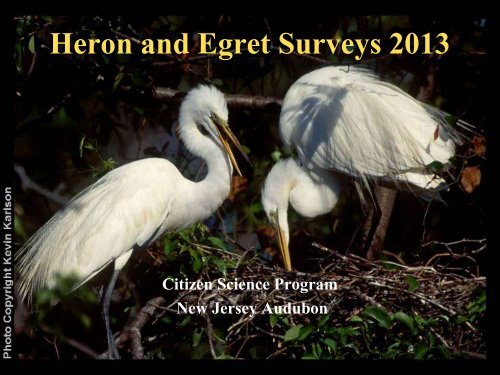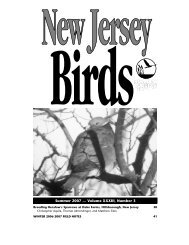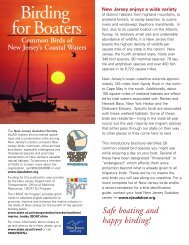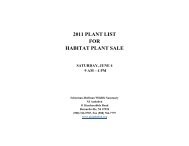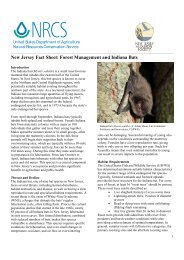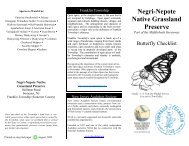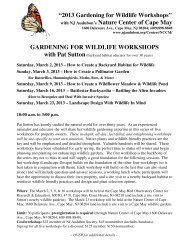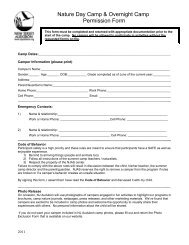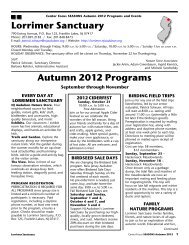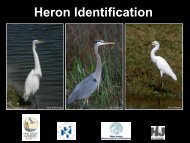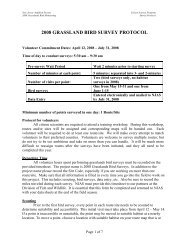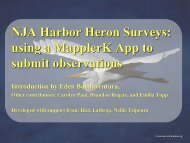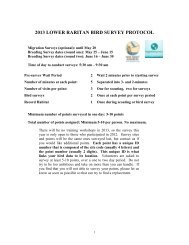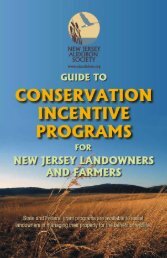Introduction - New Jersey Audubon Society
Introduction - New Jersey Audubon Society
Introduction - New Jersey Audubon Society
You also want an ePaper? Increase the reach of your titles
YUMPU automatically turns print PDFs into web optimized ePapers that Google loves.
Heron and Egret Surveys 2013<br />
Citizen Science Program<br />
<strong>New</strong> <strong>Jersey</strong> <strong>Audubon</strong>
1. <strong>Introduction</strong><br />
Workshop Outline<br />
• NJA Citizen Science<br />
• Goals of the Harbor Heron Project<br />
• 2008-2012 Results<br />
2. What is new this year<br />
• Roost surveys<br />
• MapplerK observations<br />
Photo by: Mike Lyncheski<br />
3. Species Identification<br />
4. Survey Methodology
Citizen Science<br />
• Through Citizen Science we can collect large<br />
samples of data on bird species throughout a wide<br />
geographic area<br />
• Not a new concept. Citizen science type<br />
programs, such as the Christmas Bird Count<br />
(National <strong>Audubon</strong>) and the Breeding Bird<br />
Survey (USGS), have existed for decades
Goals of NJA Citizen Science<br />
• To promote habitat preservation by improving our<br />
knowledge of the ecology of <strong>New</strong> <strong>Jersey</strong> through the<br />
contributions of Citizen Scientists<br />
• To involve the public (Citizen Scientists) in the process<br />
of collecting ecological data<br />
– Increased awareness makes citizen scientists active<br />
participants in conservation
Shorebird Surveys<br />
Ongoing
Grassland Bird Surveys<br />
Ongoing
Nightjar Surveys<br />
Northeast<br />
Coordinated<br />
Bird Monitoring<br />
Photo by Michael Allen<br />
Ongoing
Lower Raritan<br />
Surveys<br />
Initiated 2012
Heron Surveys
Harbor Heron Surveys<br />
• Collaborative effort of<br />
NJA and NYCA<br />
• Fill gaps in knowledge in<br />
the <strong>New</strong> <strong>Jersey</strong> Wildlife<br />
Action Plan for coastal<br />
areas in the Hackensack<br />
Meadowlands and the<br />
Raritan Bay<br />
• Collect information<br />
needed for the Harbor<br />
Heron Conservation Plan
NJA Heron Survey Objectives<br />
• To determine the<br />
abundance and distribution<br />
of long-legged colonial<br />
water birds at various sites<br />
and habitats<br />
• To look at post breeding<br />
roosts and movements<br />
• To mobilize, train, and<br />
coordinate citizen scientists<br />
in conducting these surveys
Harbor Herons<br />
• Long-legged Wading birds<br />
(Order Ciconiiformes)<br />
• Primarily piscivorous,<br />
though flexible<br />
• Long lived with low to<br />
moderate reproduction<br />
rates<br />
• Typically breed in colonies<br />
Photo by Don McCrimmon
What is a colony?<br />
• Breeding aggregations (of birds) nesting close to<br />
each other, feeding outside the nesting area, and<br />
behaviorally synchronized through social stimuli
History of “Harbor Herons”<br />
• 1974 – HH “discovery” on Prall’s by Scottie<br />
Jenkins - reported to NYC <strong>Audubon</strong> (1978 –<br />
Shooters)<br />
• Initial conservation efforts 1979<br />
• 1985 – NYC <strong>Audubon</strong> HH commences<br />
• 1997 – new islands explored and included<br />
• Harbor Heron Subcommittee of HEP working<br />
on Conservation Plan for the birds and habitat<br />
in the harbor
Harbor Heron Breeding Colonies<br />
(Rookeries)
1989<br />
1990<br />
1991<br />
1992<br />
1993<br />
1994<br />
1995<br />
1996<br />
1997<br />
1999<br />
2000<br />
2001<br />
2002<br />
2003<br />
2004<br />
2005<br />
2007<br />
2009<br />
Harbor Heron Breeding Surveys<br />
2500<br />
2000<br />
1500<br />
1000<br />
500<br />
0<br />
NY Harbor Heron Breeding Surveys<br />
1985-2009
Harbor Heron Feeding Areas<br />
• Birds fly from nesting colonies on NY/NJ Harbor<br />
islands to other areas where they forage<br />
• Much more is known about the breeding colony<br />
use than foraging habitat use<br />
– Surveys of herons away from breeding colony<br />
more challenging
Harbor Heron Project questions<br />
• Where do birds from each specific island<br />
colony forage?<br />
• What areas are used by the Harbor Herons<br />
away from the nesting colony and how?
Where do birds from each island<br />
go to forage and loaf?<br />
– Flight direction information<br />
– Tagging and telemetry
Flight direction information<br />
Charting directions at the colonies (NYCA)<br />
Brother Islands, Flight Directions for All Birds (all birds = 100%)<br />
N<br />
Hoffman Island, Flight Directions for All Birds (all birds = 100%)<br />
N<br />
100<br />
80<br />
100<br />
80<br />
60<br />
60<br />
40<br />
40<br />
20<br />
20<br />
W<br />
100 80 60 40 20 20 40 60 80 100<br />
E<br />
W<br />
100 80 60 40 20 20 40 60 80 100<br />
E<br />
20<br />
20<br />
40<br />
40<br />
60<br />
60<br />
80<br />
80<br />
100<br />
100<br />
S<br />
S
Where do birds from each island<br />
go to forage and loaf?<br />
– Flight direction information<br />
– Tagging and telemetry
Tagging and telemetry
Where do they go??<br />
• Counts at foraging grounds
2008 - 2012: Some data
Survey Sites<br />
NJA (2008-2012)<br />
• 45 Sites<br />
• 228 Points<br />
NYCA (2009-2012)<br />
• 20 Sites<br />
• > 110 Points
NJ Primary Focal Areas<br />
Meadowlands<br />
Raritan
Non-nesting habitat use<br />
• What areas and habitats are used by the<br />
Harbor Herons and how?<br />
– Tide and time of day<br />
– Foraging success<br />
– Time/activity budgets<br />
– Interactions with other herons and<br />
egrets<br />
– Seasonal patterns
Volunteer Participation
2012<br />
28 NJA and 15 NYCA volunteers<br />
• Surveyed 32 sites<br />
• Made 380 site visits<br />
• Conducted 1,902 point surveys<br />
• Observed 5,046 herons and egrets
Conclusions<br />
• Great Egrets observed in all areas<br />
• Snowy Egrets second most common<br />
• Generally more Snowy than Great<br />
Egrets seen in the NY survey area<br />
• Snowy Egrets were especially<br />
abundant at some Meadowlands sites
Using surveys of foraging areas as an indicator<br />
of local movements of egrets<br />
Nellie Tsipoura 1 , Kristin Mylecraine Munafo 1 , Elizabeth Ng 1 , Susan Elbin 2<br />
1<br />
<strong>New</strong> <strong>Jersey</strong> <strong>Audubon</strong>, and 2 <strong>New</strong> York City <strong>Audubon</strong>
Local movements<br />
• How far are the egrets traveling from the<br />
breeding colonies?
Total # of GREG Observed<br />
Abundance at each survey site plotted<br />
against distance from breeding colonies<br />
250<br />
200<br />
2009<br />
150<br />
100<br />
50<br />
0<br />
0 10 20 30 40 50 60<br />
Distance to nearest colony (km)
Total # of GREG Observed<br />
Abundance at each survey site plotted<br />
against distance from breeding colonies<br />
250<br />
200<br />
2010<br />
150<br />
100<br />
50<br />
0<br />
0 10 20 30 40 50 60<br />
Distance to nearest colony (km)
12 km<br />
3 km
12 km<br />
3 km
Temporal changes<br />
• Changes in site use reflect different patterns<br />
of local movements in the study area at<br />
different times of the breeding cycle
250<br />
200<br />
Total Number of Egrets -- 2010<br />
150<br />
100<br />
50<br />
0<br />
May 1-<br />
15<br />
May<br />
16-31<br />
June 1-<br />
15<br />
June<br />
16-30<br />
July 1-<br />
15<br />
Juy 16-<br />
31<br />
Aug 1-<br />
15<br />
Aug<br />
16-31<br />
Sept 1-<br />
15<br />
Sept<br />
15-30<br />
Oct 1-<br />
15<br />
Oct 16-<br />
21<br />
CHQU EDAV HAME JABA KING MAWA<br />
MRI OVCR PEBP RACE SACR SAHO
80<br />
Seasonal use of all sites - 2010<br />
70<br />
60<br />
50<br />
40<br />
30<br />
20<br />
10<br />
0<br />
May 1-<br />
15<br />
May<br />
16-31<br />
June 1-<br />
15<br />
June<br />
16-30<br />
July 1-<br />
15<br />
Juy 16-<br />
31<br />
Aug 1-<br />
15<br />
Aug 16-<br />
31<br />
Sept 1-<br />
15<br />
Sept<br />
15-30<br />
Oct 1-<br />
15<br />
Oct 16-<br />
21<br />
Meadowlands NY Raritan Upper Hackensack
70<br />
Seasonal use in the Meadowlands by<br />
Great Egrets - 2011<br />
60<br />
50<br />
40<br />
30<br />
20<br />
10<br />
0<br />
July 15-31 Aug 1-15 Aug 16-31 Sept 1-15 Sept 16-30 Oct 1-15 Oct 16-31<br />
HAME KBRM KING MRI SACR SAWM
35<br />
Seasonal use by Great Egrets in the<br />
Raritan - 2011<br />
30<br />
25<br />
20<br />
15<br />
10<br />
5<br />
0<br />
July 15-31 Aug 1-15 Aug 16-31 Sept 1-15 Sept 16-30 Oct 1-15 Oct 16-31<br />
CHQU EDAV LAHA NALA RACE SAHO
Conclusions<br />
• Great Egrets observed in Meadowlands,<br />
Raritan and Arthur Kill watersheds and<br />
in Jamaica Bay and Pelham Bay in large<br />
numbers<br />
• Foraging site use reflects numbers of<br />
birds in breeding colonies<br />
• Site use patterns suggest local movements<br />
of birds during the breeding season with<br />
post fledging increases at all sites
2013 Activities<br />
• “Harbor Heron” foraging survey<br />
• Roost searches and Roost survey<br />
• Pilot the use of a smart phone app to<br />
submit observations.
The Great Egret Roost Blitz<br />
2012<br />
Mapping and Monitoring Autumnal<br />
Waterbird Roosts in the NY/NJ Metro Area<br />
Mike Allen 1 , Nellie Tsipoura 1 , Susan Elbin 2 ,<br />
John Rowden 2 , and Chip Weseloh 3<br />
1<br />
NJ <strong>Audubon</strong>, 2 NYC <strong>Audubon</strong>, 3 Canadian Wildlife Service
What is an ‘Autumnal Roost’?<br />
• Communal sleeping area (usually in trees)<br />
• Occupied from after breeding through Fall<br />
– A time of wandering & migration for egrets<br />
• Sizes vary, but often several dozen egrets<br />
– Roosts ranging from 2 to 700+ reported in<br />
Ontario<br />
• Often mixed-species<br />
– Mainly egrets, cormorants, and night-herons<br />
• Used perennially<br />
– One in NJ active since at least since the 70’s<br />
(Rich Kane, pers. comm.).
What is an ‘Autumnal Roost’?<br />
• Habitat characteristics<br />
– Treed islands, trees over water (similar to breeding<br />
colonies)<br />
– Can also be in shallow water or on mudflats<br />
(Ontario)<br />
• Often central to good foraging areas<br />
– May help ‘newcomer’ migrants find food?<br />
– In ON, whole roosts sometimes depart together for<br />
the same feeding area<br />
• Sensitive to disturbance<br />
– Known to abandon roosts, often temporarily
Photo by Allen Woodliffe
Methods: The Blitz<br />
• Roost Blitz: September 14 th - 23 rd<br />
– Asked NYC <strong>Audubon</strong> and NJ <strong>Audubon</strong> Harbor Herons<br />
volunteers to visit their sites from dusk to dark<br />
– Note numbers of egrets, flight direction<br />
– Visit again and triangulate<br />
• A twilight fly-over of the Raritan Bay area<br />
– Volunteer pilot working with LightHawk<br />
• Post-blitz efforts:<br />
– Followed up on tips from volunteers<br />
– Reached out to other birders, professionals<br />
– Additional scouting by car and by boat
Methods: Monitoring<br />
• Based on Chip W’s Ontario protocol<br />
• Visit 2x weekly if possible (not this time!)<br />
• Count arrivals/departures in 10 min intervals<br />
– Evening: 20-30 min before sunset until dark<br />
– Morning: 20-30 min before sunrise until all<br />
birds leave<br />
• Counts by staff and volunteers<br />
– Mike Dixon, Debbie Schmidt, Liv Vreeland, Dan<br />
Morley and others
Results
Foraging Birds
Sites searched* / Roosts found<br />
• Staten Island: Bridge Creek, other sites<br />
• Queens: Jamaica Bay<br />
• Meadowlands: Kearny Marsh, Cheesequake<br />
Creek, Sawmill Creek WMA, Laurel Hill,<br />
DeKorte Park, Harrier Meadow, Clay Ave.<br />
• Raritan Bayshore: Natco Lake, Lake<br />
Matawan, Compton’s Creek<br />
• Bayonne / <strong>Jersey</strong> City: Lefante Walkway,<br />
Lincoln Park<br />
*Visited at dusk by NYC <strong>Audubon</strong> and NJ <strong>Audubon</strong> citizen scientists during blitz.
Thanks to the NYC and NJ<br />
<strong>Audubon</strong> volunteers who helped find<br />
• Joe O’Sullivan<br />
• Catherine Barron<br />
• Jeff and Lynn<br />
Krauss<br />
• Mike Dixon<br />
• Liz Vreeland<br />
• Debbie Schmidt<br />
• Dan Morley<br />
• Jim Ceravolo<br />
• Bill Schultz<br />
• Pat Hilliard<br />
• George Pitcher<br />
roosts!<br />
• Mike Britt<br />
• Charlene Burke<br />
• Tom Shinskey<br />
• Lene De Coursin<br />
• Camille Gutmore<br />
• Jerry Golub<br />
• Becky James<br />
• Mike Fedosh<br />
• Joe Fischetti (pilot)<br />
• LightHawk (non-profit)<br />
• Eileen and Stanley Smith
Roost Characteristics<br />
• All 8 were in mid-sized trees<br />
• All 8 were next to water<br />
– 6 of 8 near ~ freshwater<br />
– Observed drinking<br />
• Only 2 of 8 were on an island<br />
• Closest together: 2.5 km
Species Composition<br />
• In addition to Great Egrets:<br />
– Gr. Blue Heron: at least 4 of 8 roosts (low<br />
#’s)<br />
– B.C. Night-heron: at least 4 of 8 roosts<br />
(#’s varied)<br />
– D.C. Cormorant: 2 of 8 (large #’s at one,<br />
not other)<br />
– Snowy Egret: 2 of 8 (separate area in<br />
Cormorants outnumber Kearny)<br />
Great Egrets<br />
at the Lake Matawan roost<br />
Snowy Egrets at the Kearny Roost sleep<br />
Separately from the Greats.<br />
Great Egrets at the Kearny Roost.
Roost Profiles
Kearny Roost<br />
Our largest roost, it has been in use since at least the 1970’s! (R. Kane, pers. comm.)
Lake Matawan Roost<br />
Our 2 nd largest roost, in use for at least several years. (L. Vreeland, pers. comm.)
Cheesequake Roost<br />
Our 3 rd largest roost, in use for at least several years. (B. Schultz, pers. comm.)
Seasonal Patterns<br />
Roost<br />
• 11 evening counts, all starting 20-30+ min before sunset<br />
• 4 morning counts, all starting 20-30+ min before sunrise
Reaction to Disturbance<br />
Cheesequake Roost 6:37 pm 6:39 pm<br />
Entering roost as<br />
boat approaches<br />
Most flushed as<br />
boat passed<br />
6:41 pm 6:48 pm<br />
Waited it out<br />
in the marsh<br />
Back to<br />
normal
Reaction to Disturbance<br />
Kearny Roost: “two duck hunters<br />
continually flushing the [BCNH] on the<br />
near abandoned RR bed…Oddly<br />
enough, I don't think the hunters<br />
spooked any egrets once they got to the<br />
roost.” –Mike Dixon, Oct 6 th<br />
This roost had moved permanently<br />
0.5km away by next visit on Oct 14 th
Timing of Roost Entry & Exit
Conclusions<br />
• Roost characteristics / species composition<br />
– Freshwater seems to be important<br />
– Proximity to good foraging areas<br />
– No clear species patterns, but mix similar to breeding<br />
colonies<br />
• Seasonality / timing<br />
– Need better coverage in future years<br />
– Not a typical year? (Sandy)<br />
– Timing info will help in planning next year<br />
• Disturbance<br />
– Reason Cheesequake & Kearny Roosts apparently moved?<br />
– Is duck hunting a factor? It is in Ontario.
Roost monitoring<br />
• Liz Vreeland presents: A citizen scientist’s<br />
experience
2013<br />
• Find more roosts!<br />
• Monitor the 8 known roosts<br />
– Ideally, weekly starting in June-July and biweekly<br />
once they are active<br />
– Try spring monitoring at largest roosts?<br />
• Roosts are occupied more sparsely in<br />
spring


